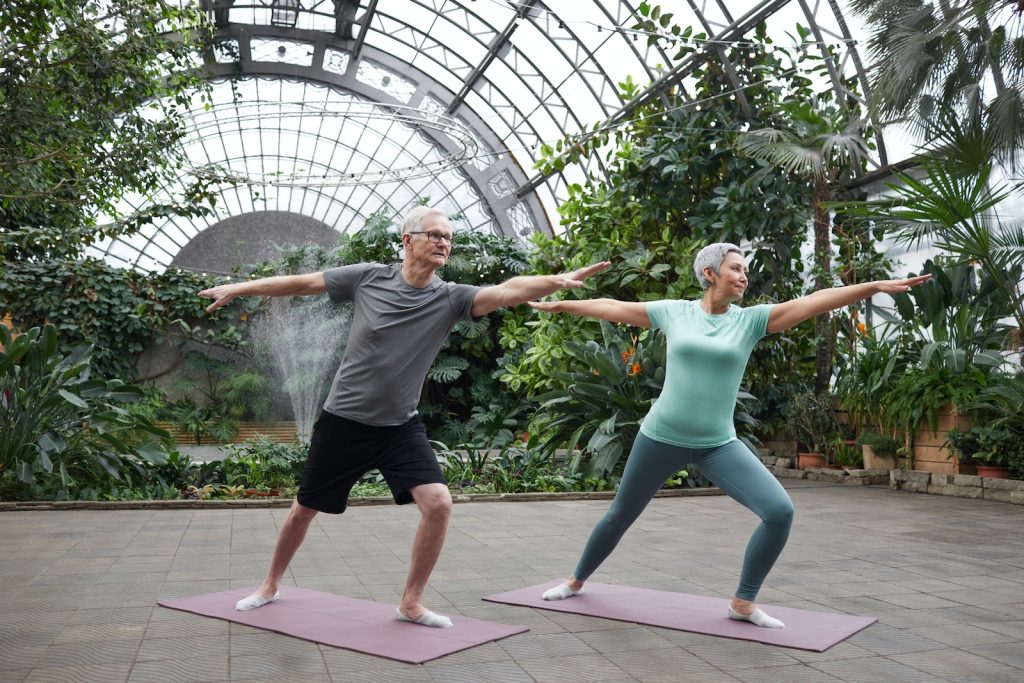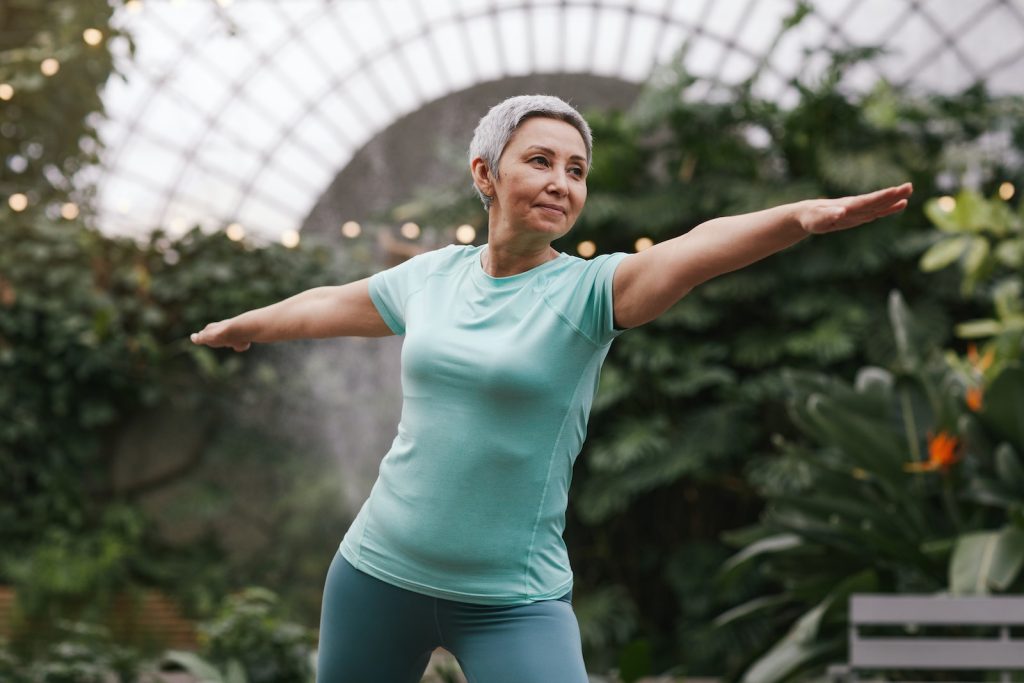Tips for Staying Active and Healthy in Your Golden Years
As you age, it is important to adjust your exercise routine to fit your body’s changing needs. Exercise is an essential part of maintaining your health and overall well-being, but the type and intensity of exercise that works for you in your 30s or 40s may not be appropriate for you in your 60s. As you enter your golden years, you may find that you need to make some changes to your exercise regimen to continue to reap the benefits of physical activity.

One of the biggest changes you may notice in your 60s is a decrease in muscle mass and bone density. This can put you at risk for falls and fractures, so it is important to incorporate exercises that help maintain your strength and balance. Additionally, joint pain and stiffness may become more common as you age, so low-impact exercises like swimming, yoga, or cycling may be more comfortable for you than high-impact exercises like running or jumping.
Another factor to consider as you age is the importance of recovery time. Your body may not bounce back as quickly as it used to, so it is important to listen to your body and take rest days as needed. You may also want to incorporate stretching and foam rolling into your routine to help prevent injury and keep your muscles and joints healthy. By making these adjustments to your exercise regimen, you can continue to stay active and healthy well into your 60s and beyond.
Understanding Exercise Needs in Our 60s
 As you hit your 60s, your body goes through several changes that can affect your exercise needs. Understanding these changes is crucial to create an exercise regimen that works for you.
As you hit your 60s, your body goes through several changes that can affect your exercise needs. Understanding these changes is crucial to create an exercise regimen that works for you.
One of the most significant changes is a decline in muscle mass, which can lead to weakness and a higher risk of falls. To combat this, you should focus on strength training exercises that target your major muscle groups. This can include weightlifting, resistance band exercises, and bodyweight exercises such as squats and lunges.
Another change is a decrease in bone density, which can increase your risk of fractures. Weight-bearing exercises such as walking, jogging, and dancing can help maintain bone density and reduce the risk of osteoporosis.
Additionally, cardiovascular health becomes increasingly important as you age. Regular aerobic exercise such as brisk walking, cycling, or swimming can improve heart health and reduce the risk of heart disease.
It’s also important to listen to your body and adjust your exercise regimen accordingly. As you age, your body may take longer to recover from intense workouts, so it’s essential to incorporate rest days and low-impact exercises such as yoga or stretching.
Overall, creating an exercise regimen that includes strength training, weight-bearing exercises, aerobic exercise, and rest days can help you stay healthy and active in your 60s and beyond.
Adapting Exercise Regimens

As you enter your 60s, it’s important to adapt your exercise regimen to meet your changing needs. While exercise is still essential for maintaining good health, you may need to make some modifications to prevent injury and maximize the benefits of your workouts.
One important consideration is to focus on low-impact exercises that are easier on your joints. Walking, swimming, and cycling are great options that can help you stay active without putting too much strain on your body. You may also want to incorporate strength training exercises to maintain muscle mass and bone density.
Another important aspect of adapting your exercise regimen is to listen to your body and adjust your routine accordingly. If you experience pain or discomfort during a particular exercise, it’s important to modify or avoid that exercise to prevent injury. It’s also important to gradually increase the intensity and duration of your workouts to avoid overexertion.
Finally, it’s important to stay hydrated and fuel your body with nutritious foods to support your exercise routine. Drinking plenty of water and eating a balanced diet can help you maintain your energy levels and recover more quickly from your workouts.
By adapting your exercise regimen to meet your changing needs, you can continue to enjoy the many benefits of regular exercise well into your 60s and beyond.
Cardiovascular Workouts for Seniors

Maintaining cardiovascular health is crucial as you age, and regular exercise can help keep your heart and lungs healthy. Here are some of the best cardiovascular workouts for seniors:
Walking
Walking is a low-impact exercise that is easy on your joints and can be done anywhere. It is a great way to get your heart rate up and improve your cardiovascular health. You can start by walking for 10-15 minutes a day and gradually increase the duration and intensity of your walks.
Swimming
Swimming is another low-impact exercise that is great for seniors. It is easy on your joints and can help improve your cardiovascular health, as well as your strength and flexibility. Swimming can also help reduce stress and improve your mood.
Cycling
Cycling is a great way to get your heart rate up and improve your cardiovascular health. It is a low-impact exercise that is easy on your joints and can be done indoors or outdoors. You can start by cycling for 10-15 minutes a day and gradually increase the duration and intensity of your rides.
Remember to always consult with your doctor before starting any new exercise regimen, especially if you have any underlying health conditions. It is also important to listen to your body and not push yourself too hard. Start slowly and gradually increase the duration and intensity of your workouts over time.
Strength Training in Our 60s

As you age, it becomes even more important to maintain your strength. Strength training can help you maintain muscle mass, bone density, and balance. Here are a few types of strength training you can try in your 60s:
Resistance Bands
Resistance bands are a great way to build strength without putting too much stress on your joints. They come in different levels of resistance, so you can choose the one that’s right for you. Here are a few exercises you can do with resistance bands:
- Bicep curls
- Tricep extensions
- Leg presses
- Chest presses
Weight Lifting
Weight lifting is another great way to build strength, but it’s important to start slowly and use proper form. Here are a few exercises you can do with weights:
- Squats
- Lunges
- Chest presses
- Shoulder presses
Yoga
Yoga is a great way to build strength and flexibility. It can also help improve your balance and reduce stress. Here are a few yoga poses you can try:
- Warrior II
- Tree pose
- Downward dog
- Plank
Remember to always warm up before you start strength training and to listen to your body. If you experience any pain or discomfort, stop and talk to your doctor.
Flexibility and Balance

As you hit your 60s, maintaining flexibility and balance becomes increasingly important. These two factors play a crucial role in preventing falls and maintaining mobility. Fortunately, there are several exercise regimens that can help you improve your flexibility and balance.
Tai Chi
Tai Chi is a low-impact exercise that involves slow, flowing movements. It is a great way to improve your balance, flexibility, and strength. Tai Chi can also help reduce stress and improve mental health. The movements are gentle and easy to learn, making it a great exercise for beginners.
Pilates
Pilates is a form of exercise that focuses on strengthening the core muscles. It can help improve your posture, balance, and flexibility. Pilates involves a series of controlled movements that target specific muscle groups. It is a low-impact exercise that is suitable for people of all ages.
Stretching Routines
Stretching is a simple and effective way to improve your flexibility. Regular stretching can help reduce stiffness and improve range of motion. There are several stretching routines that you can do at home, such as hamstring stretches, calf stretches, and shoulder stretches. It is important to stretch slowly and gently, and to avoid overstretching.
In conclusion, incorporating exercises that improve your flexibility and balance into your workout routine can help you maintain mobility and prevent falls as you age. Tai Chi, Pilates, and stretching routines are all great options to consider.
Incorporating Rest and Recovery

As you age, it’s important to incorporate rest and recovery into your exercise routine. Your body needs more time to recover and repair itself, and pushing yourself too hard can lead to injury or burnout.
One way to incorporate rest is to schedule recovery days into your routine. This means taking a break from intense exercise and doing something lighter, like stretching or yoga. You can also take a day off completely and focus on relaxation and recovery.
Another way to incorporate rest is to listen to your body. If you’re feeling tired or sore, it’s okay to take a break and give your body time to recover. Pushing through pain or fatigue can lead to injury and setbacks in your fitness journey.
In addition to rest days, it’s important to prioritize recovery after each workout. This includes stretching, foam rolling, and other forms of self-massage to help your muscles recover. You can also try taking an ice bath or using a heating pad to reduce inflammation and promote healing.
Remember, rest and recovery are just as important as exercise itself. By incorporating these practices into your routine, you can stay healthy and active well into your 60s and beyond.
Consulting with Health Professionals

As you age, your body changes, and it’s essential to consult with your healthcare provider to determine the best exercise regimen for you. Your doctor can help you determine what types of exercises will be safe and effective for your current health condition.
Your healthcare provider can also help you create a plan that takes into account any pre-existing conditions or injuries you may have. For example, if you have arthritis, your doctor may recommend low-impact exercises, such as swimming or cycling, to help reduce joint pain.
It’s also important to discuss any medications you’re taking with your healthcare provider. Some medications can cause dizziness or other side effects that may impact your ability to exercise safely. Your doctor can help you determine the best time of day to exercise and whether you need to adjust your medication schedule.
In addition to consulting with your doctor, you may also want to consider working with a physical therapist or personal trainer who specializes in working with older adults. These professionals can help you develop a safe and effective exercise program that meets your individual needs and goals.
Remember, it’s never too late to start exercising, but it’s important to do so safely. By consulting with your healthcare provider and working with a qualified professional, you can create an exercise regimen that will help you stay healthy and active as you age.
Conclusion

In your 60s, exercise regimens may need to be adjusted to accommodate changes in your body. It’s important to focus on low-impact exercises that can help maintain muscle and bone strength, improve balance, and reduce the risk of injury.
Incorporating resistance training, such as using weights or resistance bands, can help maintain muscle mass and improve bone density. Yoga and Pilates can also be beneficial for improving balance and flexibility.
It’s important to listen to your body and not push yourself too hard. Rest and recovery are just as important as exercise itself. Don’t be afraid to modify exercises or take breaks as needed.
Remember to also prioritize cardiovascular exercise, such as brisk walking or cycling, to maintain heart health. And don’t forget to have fun! Exercise can be enjoyable and social, so consider joining a fitness class or group to stay motivated and engaged.
Rod Barnes
Rod Barnes has authored several websites with a wide variety of subjects.
He is a Vietnam Veteran with broad experience in business. He is especially interested in providing resources for our aging population.